Great Western Trail has a pacing problem.
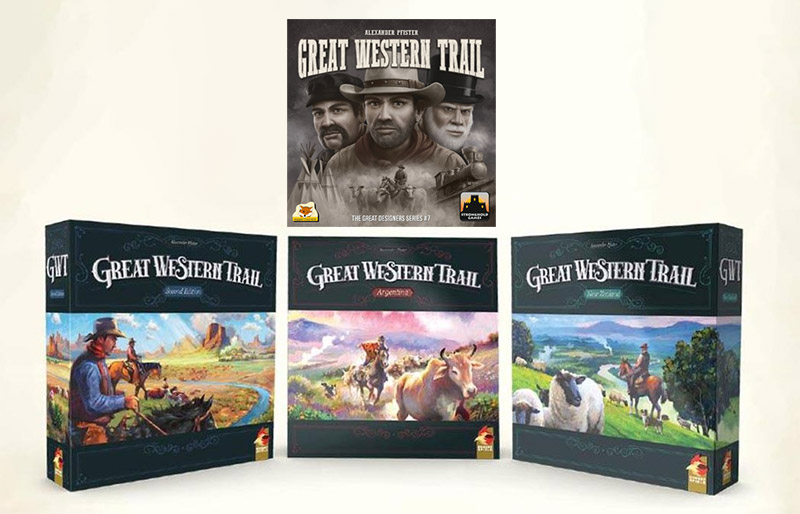
The board game developed by Austrian designer Alexander Pfister found an audience, some of whom claim it’s his best work, despite its objectively terrible cover. It came under fire for its inclusion of indigenous North Americans, which its rulebook called “Indians” — a term that runs the gamut from “highly objectionable” to “what we actually call ourselves,” depending on which people group you ask. The publisher responded to accusations of cultural insensitivity by releasing a new and improved second edition, which spuriously replaced “Indians” with criminal bandits. PR crisis solved! (?) But the biggest issue we have with the game is that we’re not in any hurry to play it.
Under the Horse’s Hood
It’s a neat game, for sure: it features a “rondel” mechanic where you trot your cowboy up the titular trail using a certain number of movement points each turn, optionally stopping at buildings owned either by no one in particular, or by you and your opponents, to perform certain actions. Each player has an identical hand of cattle cards of different values, and when you reach the top of the trail, you cash in whatever hand you’ve wrangled for cash and prizes. Some of these prizes include removing discs from your player board to uncover additional abilities, a mainstay of Pfister’s designs.
The game’s “clock” is at the side of the board. Each time a player ships a hand of cattle off, new employable workers are added to a grid from top to bottom, and as they file in, they push a token down the board. When the token is pushed off the bottom of the grid, endgame is triggered, and all other players get one more turn to finish out the game.
Stream? More like a Trickle
We played GWT: Argentina, the second entry in the Great Western Trail trilogy, on the Nights Around a Table livestream as part of Pfister Pfest, a showcase and exploration of Alexander Pfister’s designs. With our past plays of GWT as sage warning, we vowed not to make it a 3 hour game; there was yet dinner to eat, and stuff to do. i’m old enough to have a bed time again. For my part, i was hoping that Argentina tightened up what for me is the game’s most glaring problem: its play length. But by the time we had signed off the stream, the two of us had been playing for five bloody hours.
Granted, yes, streaming adds significant stall to gameplay. You have to interface with viewers in chat. You have to telegraph your moves so the camera operator can switch shots on time. You have to explain what you’re doing, half-teaching the game as you play, particularly for people joining the stream at staggered entry points. And of course, there are the inevitable technical issues. On this particular stream, it was our Player 2 camera refused to charge (again), and conked out early in the process. We switched the camera out, painfully, live on stream, and that ate up eleven minutes.
But let’s be generous and shave off a whopping two hours from that play time. We were still at the table for a solid three hours, rehashing the very thing we didn’t enjoy about Great Western Trail to begin with. Cheryl and i both agreed that it starts out fun, but that fun peters out about halfway down the job board. What remains is a tortuous slog of a game that, like a bad houseguest, overstays its welcome by an audacious amount, and is still rooting through your refrigerator asking what’s to eat long after you’ve put on jammies and snuggled into bed, asking Great Western Trail to please let itself out because you’ve got work in the morning.
As Long as a Piece of String
So where does the game go so wrong? From a fifty thousand foot view, the biggest challenge is that its play length is elastic. Great Western Trail can be completed in two hours. i’m sure i’ll field comments from outraged commenters claiming even shorter times. Hello there, in advance. i see you. Were you about to yell “an hour and a half?” Do i hear “five minutes!”? Calm yourselves. Of course you can play the game more quickly. Do you truly think that brand new players cracking the shrink on these games and tackling them for the first time will come it at anything close to the play time you’re about to shout at me in the comments section? In an age where there are just so many games to play, a bad first impression can sound a game’s death knell, and it won’t even get a second chance at someone’s table.
The game can be completed by “good players” who “know what they’re doing” and “don’t loudly eat air-fried spring rolls in the middle of the game” in about seven seconds flat. Great. It can also be completed in three hours. It can stretch to four. And, as we demonstrated, you can tease it out to five. Or play the entire day, if you want to — why not? But for grown-ups with stupid grown-up obligations they have to attend to all the time, that’s a huge problem.
If i know i have 3 hours to set up, re-learn, play, and pack a game away, i’m naturally going to reach for something i can all but guarantee will fit into that window. Johnny has baseball practice at 6. Fernando has to leave by dinnertime. And no one wants a board game they’ve sunk three hours into to go unfinished. Some of you might even scan through that livestream and complain that Cheryl and i just play too slowly. Therein lies the rub! It’s not our fault. It’s the game’s. If Great Western Trail was designed as optimally as the strategizing it demands from its participants, the game would not let us play that slowly.
Great Western Derail
There’s tons of stuff you can do in Great Western Trail. You can stop at an outpost to construct buildings. You can stop at a building to hire workers. You can trade with natives/combat highwaymen or, in GWT: Argentina, you can help out farmers with a new strength and exhaustion mechanic. In a 2-player game, you can progress along the trail in leaps of 3, but you could also jog at 2 steps, or positively crawl by spending only one movement point per turn. With seven generic buildings to start and the addition of more wayposts that appear as the game drags on, that’s potentially seven separate turns or per player before delivering your cows, which players typically do 5-6 times per game. And there’s so much to do and explore, why wouldn’t you want to crawl up the trail, milking the buildings for all of the points and advantages you possibly can?
But the only action that pushes that game clock forward is delivering cows at the top of the trail. So if every player bum-rushes the game and zips up the trail as quickly as possible, you’re guaranteed to be home in time to catch Gunsmoke. If one or more players plays quickly, and the others take their time, now your play time has doubled. And if all players at the table pick through slowly, you’d better turn the oven off, because that roast is gonna be charcoal by the time you finally tend to it.
Poor Play vs Poor Design
“But if you go one building at a time,” you say, “you’re not playing optimally.” That’s fine. And indeed, GWT has some incentives to race towards, like train stations that you can upgrade to gain perks. Argentine adds a new set of European cities with exclusive money- and points-earning spaces, to reward players for reaching the end of the trail and shipping those cows. But they’re not enough. Great Western Trail being somewhat of a “point salad” game, where points can be earned for performing a variety of tasks, there’s an equally valid argument for taking your time; the speedy hare player who aggressively ships cows will not necessarily triumph over a methodical tortoise, thanks in part to a deck of end-game goal cards that additionally reward you for combining perks you pick up along the path.
Even if travelling slowly up the trail isn’t optimal, a board game’s “punishment” for sub-optimal play should be fewer points, not longer gameplay – especially since prolonged play affects all players! Back to the race analogy, it’s like a 500m footrace where all players cross the finish line in a reasonable amount of time, but they have to keep running laps until the player in last place one-armed army crawls his way up the track, stopping in the middle to snap some selfies and write a letter home to Mom. If that were to happen in real life, the other competitors would be halfway home on the interstate, hugging their trophies. Great Western Trail ominously says “Keep running. i’ll tell you when it’s over.”
Great Western Trail isn’t the only game to suffer from this glaring design flaw. Pfister’s other rondel games like Maracaibo and Boonlake take a “go at your own speed (at your own peril)” approach that makes their durations similarly, and frustratingly, unpredictable. (My memory of it is hazy, but i suspect Boonlake may have introduced a design tweak that mitigates the issue.) Games like Terraforming Mars and the mechanically similar Ark Nova both allow players to dither around potentially for hours, gorging themselves on points and building preposterous engines, while barely touching the dials that actually advance the game clock – temperature/oxygen/hydration levels in the former, and a staff coffee break countdown in the latter. The predictable response to this criticism is “play better.” My counterpoint to Mister Pfister, and his defensive acolytes, is “design better.”
The Fix: Play the Game to Progress the Game
One possible fix is to re-jig the game so that all actions — not just selling cows — advance the game clock. This could look like a separate track where you advance a token every time a player takes a turn. Or, advance the clock token every time someone makes a stop along the trail. You could even experiment with regressing the token whenever a player skips over a stop on the trail. But the upshot is that when that timing token reaches the end of its track, the hiring board fills up with characters and the endgame-triggering token moves down, just as it would when someone sells cows the way the good Lord intended. With this kind of adjustment, in-world “game time” would be more tightly tied to real-world “play time,” and every action that happens in the game would contribute to its inevitable conclusion. The game would no longer throw up its hands and say “Player, take the wheel!” relinquishing control of its advancement to players like Cheryl and me, who clearly can’t be trusted with it.
Lessons Learned from Another Train Game
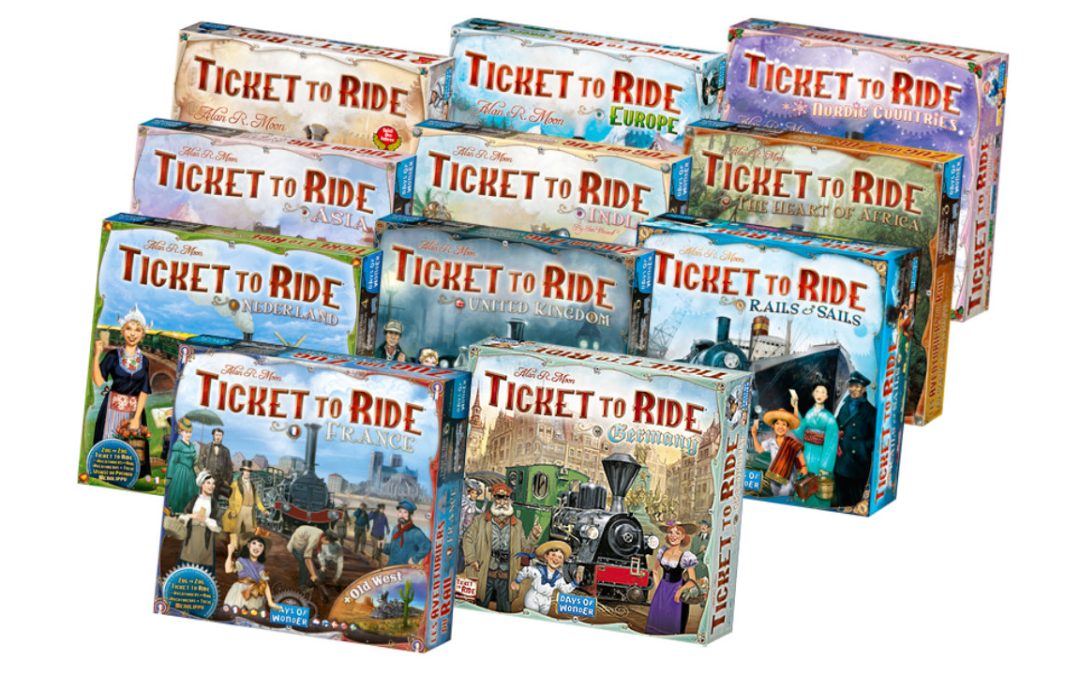
Image: acrosstheboardgamecafe.com
Great Western Trail isn’t the only board game series to enjoy multiple, similar versions. The venerable Ticket to Ride series has over a dozen variations, including different map packs. Each Ticket to Ride game purports to bring something new to the table. Ticket to Ride: Europe (my personal favourite of the bunch) adds new mechanics like tunnels and station houses. But crucially, the innovation that Ticket to Ride: San Franciso promises is a shorter game. The decision space is the same, and it plays nearly identically to its larger cousins, but in — say — half the time. And since i already know about how long it takes to play Ticket to Ride proper, i can actually do that math. Conversely, the only way to enjoy a shorter game of Great Western Trail is to play differently. Just as it’s a turn-off when you can fare better in a pay-to-win game simply by paying more money, it’s a design bungle to have a board game where play length varies dramatically depending on your in-game strategy.
Counting on Sheep
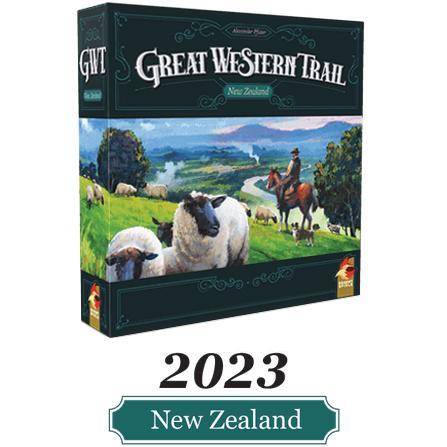
Great Western Trail has one more game to release in its trilogy. GWT: New Zealand will take us down under (and then slightly to the right) where we’ll herd sheep. Smaller animal, shorter game? Just as Ticket to Ride: Europe kept the original game’s mechanics intact but changed up a few of its mechanics, my great hope is that New Zealand will take more of a TTR: San Francisco approach, and offer us a GWT experience with a more predictable playtime that ends while we’re still having a good time.
i Hope They’ve Herd Me
Per the old adage “always leave ’em wanting more,” the best time for a game to end is when you’re still having fun with it. Unfortunatley with Great Western Trail, and even its follow-up GWT: Argentina, that fun dries up at about the halfway point, like a shrinking stream in the San Antonio sun.
GWT: New Zealand promises “more.” i’m just not sure i want any. i have things to do. For busy adult board game fans with limited time, the key to the Great Western Trail:New Zealand truly differentiating itself from its predecessors is actually in offering less.

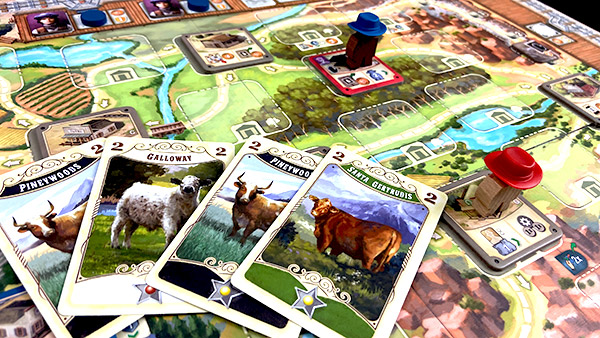
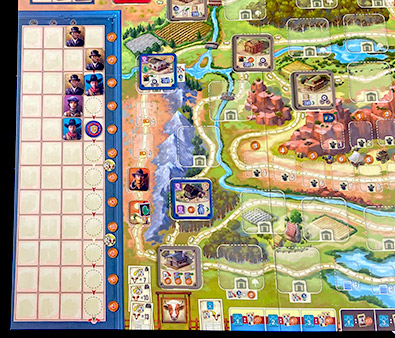

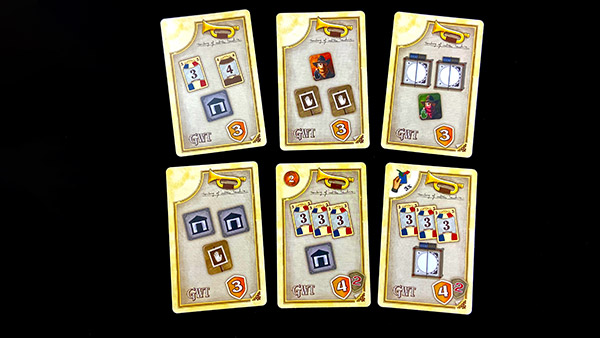








The second game in a series is usually more complicated and meaty for fans who enjoyed the first game and want more.
Once you played the first game 50-100 times, you will appreciate the next for the added complexity.
GWT is a great game, but if you do not enjoy it just play something else as there are lot of easier games, and only a few gems like GWT.
Right. And criticism from respected voices helps people better understand whether or not they make like or dislike a game, and for what reasons, before they make a purchase. As much as anyone enjoys GWT, you have to admit it’s not for everyone. This article highlights one reason why that might be the case.
With three people we still need about 5 hours for each game whenever we play it, and we once played it with 4 players which I think took over 6 hours? One person at the table was actively trying to end the game as fast as possible after about the 4th hour because she was so done with the game, which I took as a sign to never play it with 4 players again (she was only medium successful, because one person trying to zip through the game is just not enough to speed up the game as a whole that much).
I like GWT quite a lot, but I never play it if there are remotely any plans on the horizon for the day, which does seem quite limiting. It is a bit like the smaller eurogame brother of Twilight Imperium – there we really need a whole day and we better start early 😉
For sure! You can overbudget your time, and if you end early, throw a filler on the table. But underbudgeting is a recipe for disaster. If my group is going to play a full day, we want to get through 3 or 4 games instead of spending all our time on a single title. That said, i will spend (and i have spent) gobs of time playing certain games. Our last game of Trickerion spanned 7 hours. The difference is that i enjoyed the entire thing, whereas i find GWT runs out of gas far earlier.
Another way to “fix” the game is not playing it poorly as you did.
Pfister games are all about optimising your actions. You landed on sub-par actions most of the times and looked like you were clueless most of the game. Hiring is one of the most important in the game and it seems you never realised that.
Maybe next time take some time to properly prepare for a playthrough; I know it wasn’t meant as a strategy guide, but if you want to discuss design “flaws”, first I would make sure I get the designer’s intention right
My whole issue with the game is (as i’d hoped i clearly stated in this article… but maybe not?) is that a player’s performance should have no bearing on game length. Whether or not i sucked at playing the game isn’t at the heart of this discussion. My entire thesis here is that game should last roughly the same amount of time whether players are doing well or not, instead of swinging wildly plus or minus two hours. The runtime of a movie doesn’t increase with its viewers’ inability to understand its themes (no matter how esoteric or opaque those themes may be). No movie says “press pause here, and only resume watching the movie once you confirm that you understand the joke we just made.” But that’s essentially what GWT does. Anyway, maybe next time take some time to properly understand my argument.
I definitely disagree with your assessment. I love GWT, but it has flaws.
Personally I eliminated it from my 2-player games because the game is so badly designed that it’s broken at 2-players.
But a game that allows for one player or a new player to slow it from 2-hours to 5-hours is an incomplete game.
They designed a great format with lots of fun options. But one, no game should allow you to do everything in one play, that would make choice pointless. And two, no game should encourage you to never play with new or inexperienced players, which this does.
Likely a great way to keep the game as is for you but allow this fox would be to include additionally in the rules an option for easy, basic and hard play options.
Let his suggestion for speeding up the clock be marked as playing easy mode. That allows new players a chance to learn without killing off their enthusiasm.
As they learn the game, they can up to basic mode and possibly keep the game at 3-hours max, hopefully closer to that 90-minute mark.
You don’t have to design a game for everyone, but if you don’t have an entry-level setup you’re going to lose a lot of potential players. And I know that I can’t get this to the table anymore because all my friends, who love games, have marked it as unplayable now due to its average game length and lack of fun post 90 minutes.
That is the answer. I am sure you can make a lot of games last forever if you’re a bad player. Our first perhaps three games took a long time. Now we fly through it and wish we had more time.
Sorry, I disagree with you completely. I think GWT is, at best, too short. I’ve never played a game of it where I’ve felt that I’ve done all I want to. What I’m getting from this is that you’d rather not be playing GWT. A minor tweak is one thing, but you’re talking about seriously smashing the the game’s timer and in the process radically changing what can be gotten done in the game. Rebalancing all of that would take completely redesigning the game, effectively nerfing the challenge and puzzle it presents.
What I’m getting from this is that you just don’t want to play GWT. Shortening the game clock would require completely rebalancing the entire structure of the game. The number of times people actually get hands of cattle good enough to get to New York is already vanishingly low, and your suggestion would cripple that, as well as crippling the inherent puzzle of the game. My issue with rondel games is already the fact that other players get to dictate the pace of the game, but what you’re suggesting is going in the wrong direction. I like long thinky games, so your suggestion falls on deaf ears to me.
I don’t play GWT to have a short game. If I want a short game, I’ll play something else. Good tweaks are minor ones that have only a small but important improvement to the game. If, at the end of the day, you have to change the very fabric of the game… you should just play a different game. I spent many hours trying to fix Smash Up before realizing that the entire game was just broken and I wasn’t going to have fun with it regardless. Sometimes you just have to give up.
Yeah – i’m with you on Smash Up. But it only took me one play to realize i didn’t want to go near it again. With GWT, i see such great potential, but every time i play it (and perhaps because my plays are so spread out), each session just takes an eternity. Believe me: i’m no stranger to long games. i’ll happily sink 7 or 8 hours into Trickerion. The difference is that i find those 7 or 8 hours fun, because the game follows an arc. By the time i’ve delivered cows three times in GWT, i’m not exactly burning to do it three more times.
GWT is an fun romp in about three hours…. It is best at three and it will keep it inside that timeframe. As for the tweaks, I would not mess with it as the timer is the deliveries, and players may rush the game by increasing their moves my unlocking the discs for that.
The game’s designer (and others) offered a way to shorten the game that i hadn’t considered: drop a column from the game clock. Usually, you play with as many columns of employable characters as you have players, dropping a column as your player count goes down. So at 3 players, you can try 2 columns for a shorter game.